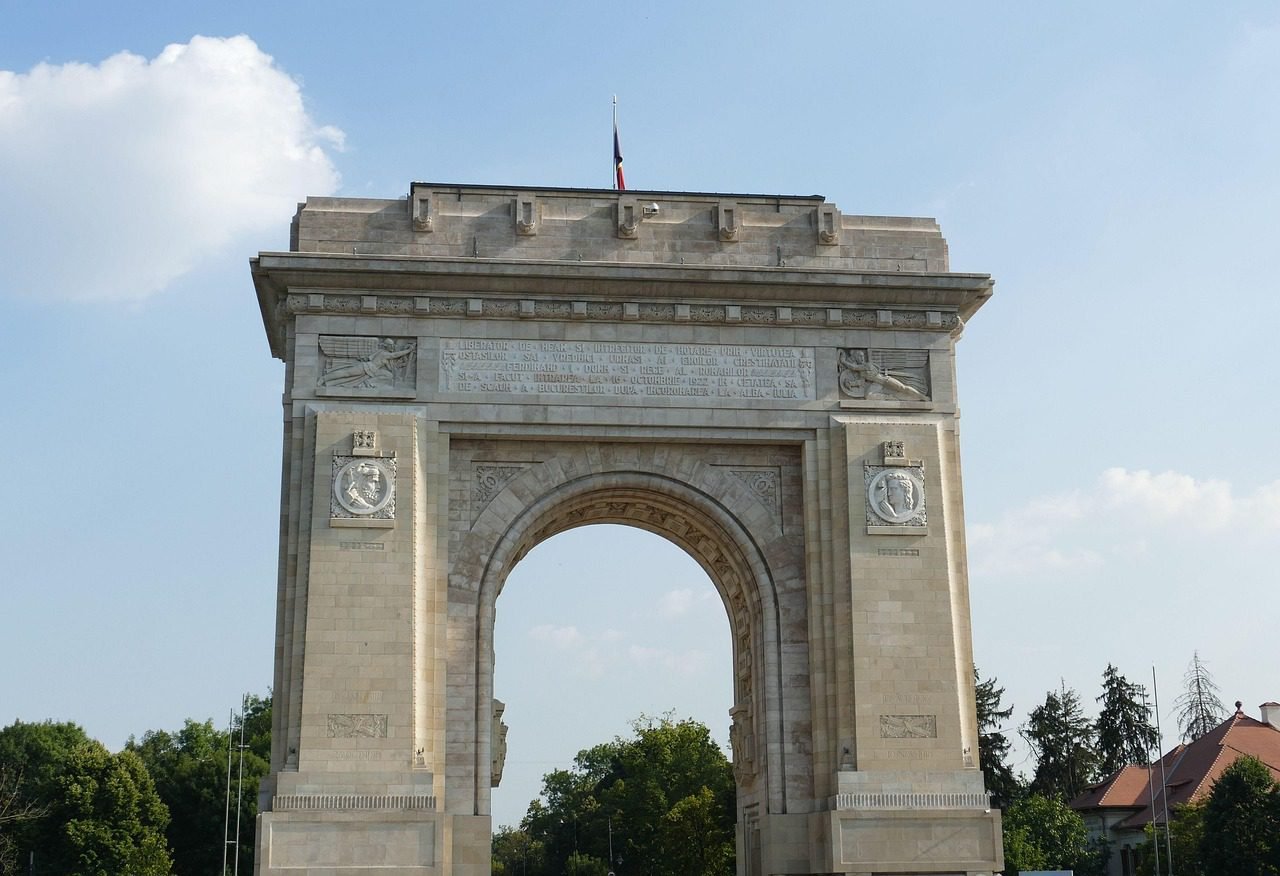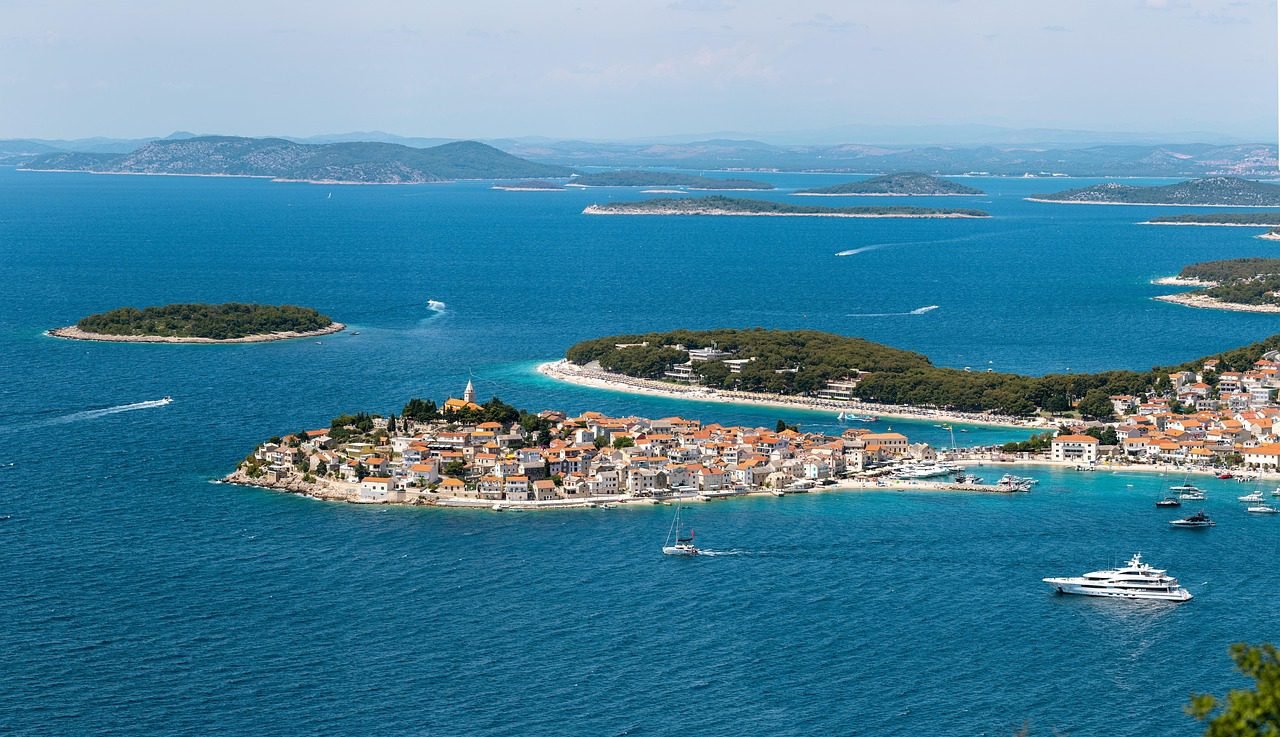Best Places to Visit in Plovdiv: Explore Bulgaria’s Cultural Gem

Plovdiv, Bulgaria’s second largest city and one of Europe’s oldest continuously inhabited urban centers, offers travelers a fascinating blend of ancient history, vibrant culture, and modern charm. This comprehensive guide will take you through the best places to visit in Plovdiv, Bulgaria, from its remarkably preserved Old Town to the trendy Kapana district, stunning Roman ruins, and delightful culinary scene. Whether you’re planning a dedicated city break or including Plovdiv in your broader Bulgarian adventure, this article provides everything you need to know to make the most of your visit to this underrated European destination.
Key Takeaways About the Best Places to Visit in Plovdiv
- Plovdiv is one of Europe’s oldest continuously inhabited cities, offering a remarkable blend of Thracian, Roman, Ottoman, and Bulgarian Revival history in one compact, walkable destination.
- The Old Town of Plovdiv features exceptionally preserved 19th-century Revival houses and cobblestone streets that create an atmospheric journey into Bulgaria’s past.
- Roman ruins, particularly the still-functioning Ancient Theatre, stand as impressive testaments to Plovdiv’s importance during the Roman Empire.
- The creative Kapana district represents Plovdiv’s contemporary cultural renaissance with its artistic spaces, craft businesses, and vibrant culinary scene.
- Plovdiv tourist attractions span thousands of years of history yet exist harmoniously alongside modern Bulgarian life.
- The city earned its designation as European Capital of Culture through its exceptional preservation of heritage and ongoing cultural vibrancy.
- Hidden gems in Plovdiv reward travelers who venture beyond the main attractions with unique perspectives on the city’s multi-layered history.
- The surrounding region offers excellent day trips that complement the city experience with monasteries, wineries, and natural beauty.
- Plovdiv’s museums provide deeper context for understanding Bulgaria’s cultural development and artistic heritage.
- With its walkable size, rich history, and cultural significance, Plovdiv deserves its growing reputation as one of the best places to visit in Eastern Europe.
What Makes Plovdiv One of Bulgaria’s Must-See Attractions?
Plovdiv is a city that surprises first-time visitors with its rich historical tapestry and cultural significance.

Built upon three hills and dating back over 8,000 years, Plovdiv is one of the oldest continuously inhabited cities in Europe.
Its strategic location made it an important settlement for Thracians, Romans, Byzantines, and Ottomans, each leaving their distinct mark on the city.
What truly sets Plovdiv apart from other Bulgarian destinations is its remarkable preservation of different historical periods existing harmoniously side by side.
Walking through the cobblestone streets, you’ll encounter ancient Roman ruins next to Revival-period Bulgarian mansions and Ottoman mosques.
This living museum quality earned Plovdiv the prestigious title of European Capital of Culture in 2019, cementing its status as one of the best places to visit in Bulgaria and a city well worth exploring in depth.
How Can You Best Experience Old Town Plovdiv?
The Old Town of Plovdiv is undoubtedly the crown jewel among Plovdiv tourist attractions and should be at the top of your itinerary.
This beautifully preserved historical quarter sits atop one of the city’s three hills and features colorful 19th-century Bulgarian Revival houses that once belonged to wealthy merchants.

These architectural masterpieces date back to the National Revival period and showcase intricate wooden details, vibrant painted facades, and overhanging upper floors.
The best way to explore Old Plovdiv is through a walking tour, allowing you to fully appreciate the atmospheric cobblestone streets and hidden courtyards. Don’t miss Hisar Kapia, the ancient gate that once served as the main entrance to the city during Ottoman times.
The Old Town also houses several museum-houses where you can step inside these magnificent structures to see how the elite lived in the 19th century.
The Balabanov House and Hindliyan House are particularly well-preserved examples that offer a glimpse into the opulent lifestyle of Plovdiv’s upper class during this fascinating period in Bulgarian history.
What Are the Most Impressive Roman Ruins to See in Plovdiv?
Plovdiv boasts some of the best-preserved Roman ruins in Eastern Europe, making them essential places to visit in Plovdiv for history enthusiasts.
The crown jewel is undoubtedly the Ancient Theatre, a magnificent 2nd-century structure that could seat 7,000 spectators.

Remarkably, this Roman theatre is still used today for concerts and performances, offering visitors the chance to experience a venue that has hosted entertainment for nearly two millennia.
Another remarkable Roman structure is the Ancient Stadium, which dates back to the 1st century and once accommodated 30,000 spectators.
While much of it lies beneath the modern city center, a portion has been excavated and is visible from Dzhumaya Square.
The Forum Complex and Roman Odeon are additional Roman ruins that showcase the importance of Trimontium (Plovdiv’s Roman name) within the empire.
These well-preserved sites allow visitors to walk in the footsteps of Roman citizens and are among the top attractions in Plovdiv, providing tangible connections to this influential period in the city’s history.
Is Kapana District Worth Visiting During Your Plovdiv Trip?
Absolutely! Kapana (meaning “The Trap” in Bulgarian) is one of the most vibrant areas in Plovdiv and represents the perfect counterbalance to the historical Old Town.
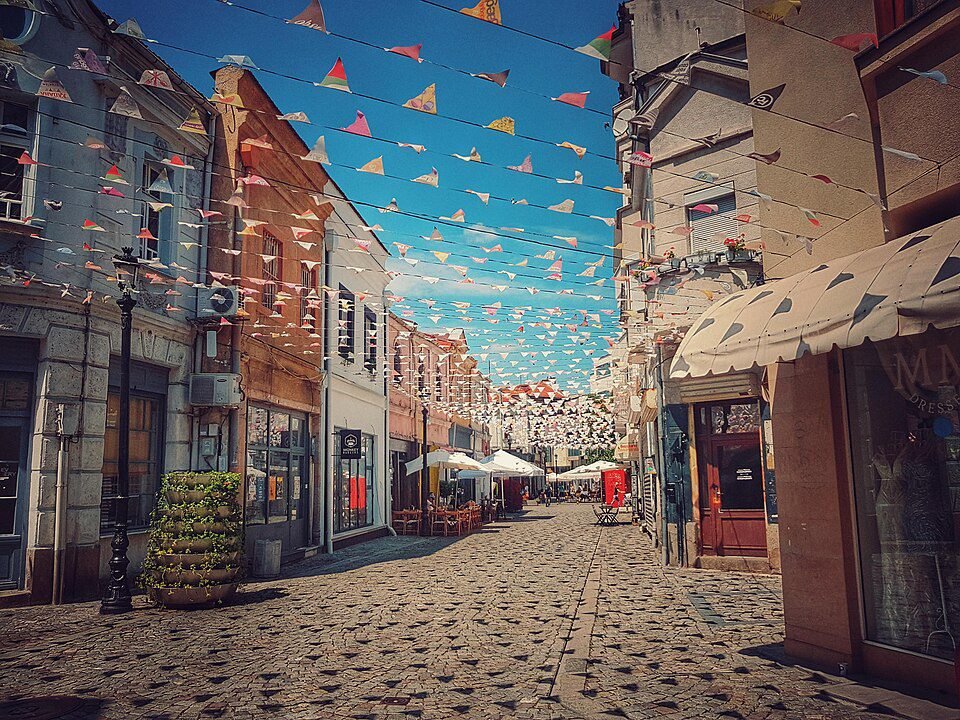
Once a neglected crafts district, Kapana has transformed into the creative heart of the city with its maze-like streets filled with hip cafes, craft beer bars, independent boutiques, and colorful street art.
Kapana has become one of the best places to visit in Plovdiv for experiencing contemporary Bulgarian culture.
The district hosts numerous cultural events, exhibitions, and festivals throughout the year.
Its narrow, car-free streets create an intimate atmosphere that invites exploration and discovery.
Wandering through Kapana, you’ll find artisan shops selling handcrafted goods alongside innovative restaurants putting modern spins on traditional Bulgarian cuisine.
The district perfectly encapsulates Plovdiv’s remarkable ability to honor its history while embracing contemporary creativity, making it a must-see attraction for visitors seeking to understand the full spectrum of this multifaceted city.
You also may like: Ultimate Guide to Traveling to Europe: Everything You Need to Know.
Which Museums in Plovdiv Should Be on Your Must-Visit List?
Plovdiv houses several excellent museums that provide deeper insights into the city’s rich history and cultural heritage.
The Regional Ethnographic Museum, housed in a stunning blue Revival-style mansion that once belonged to a wealthy merchant, showcases traditional Bulgarian costumes, crafts, and daily life artifacts.
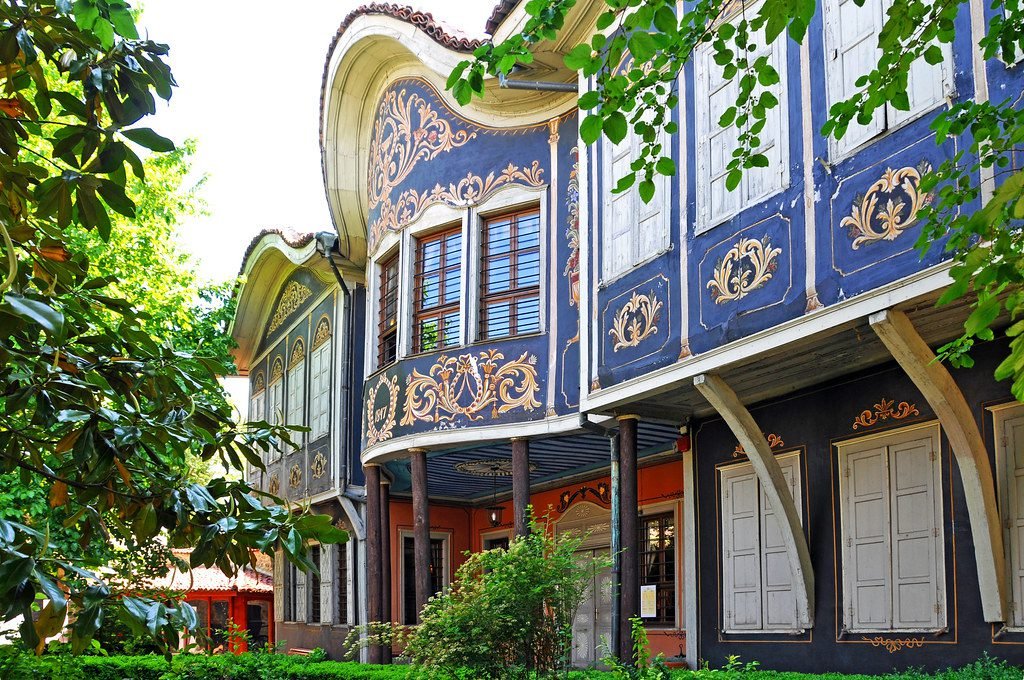
As one of the oldest museums in Bulgaria, its collection offers fascinating glimpses into rural and urban life during the National Revival period.
The Archaeological Museum is another highlight among the museums in Plovdiv, displaying treasures spanning from prehistoric times through the Roman period and beyond.
Its collection includes magnificent Thracian gold artifacts and Roman mosaics that help visitors understand the various civilizations that have called this region home.
For art enthusiasts, the City Art Gallery houses an impressive collection of Bulgarian paintings, including works by the country’s most celebrated artists.
These cultural institutions are essential places to visit in Plovdiv for anyone seeking to understand the historical and artistic context that shaped this fascinating Bulgarian city.
What Are the Best Restaurants in Plovdiv to Sample Bulgarian Cuisine?
Plovdiv offers a delightful culinary scene that combines traditional Bulgarian flavors with modern gastronomic techniques.
For authentic Bulgarian cuisine in a historical setting, Philippopolis Restaurant in the Old Town serves classic dishes like kavarma (meat and vegetable stew), banitsa (cheese pastry), and shopska salad using recipes that date back generations.

The restaurant’s terrace offers stunning views over the city, making it one of the best restaurants in Plovdiv for a special dining experience.
For a more contemporary take on Bulgarian food, head to Pavaj in the Kapana district.
This trendy spot puts creative spins on traditional recipes while maintaining authentic flavors.
Memory restaurant is another standout, located in a beautiful old house and specializing in dishes that showcase regional products from around Plovdiv and the surrounding region.
Don’t forget to try local wines from the nearby Thracian Valley, one of Bulgaria’s premier wine regions.
The city’s cafes and restaurants offer excellent opportunities to sample these distinctive wines that are still relatively unknown outside Bulgaria but are gaining international recognition for their quality and unique character.
How Should You Plan Your Day Trips from Plovdiv?
Plovdiv makes an excellent base for exploring the surrounding region, which is rich in natural beauty, historical sites, and cultural attractions.
The Bachkovo Monastery, located about 30 kilometers from Plovdiv, is one of Bulgaria’s most important Orthodox monasteries, dating back to the 11th century.
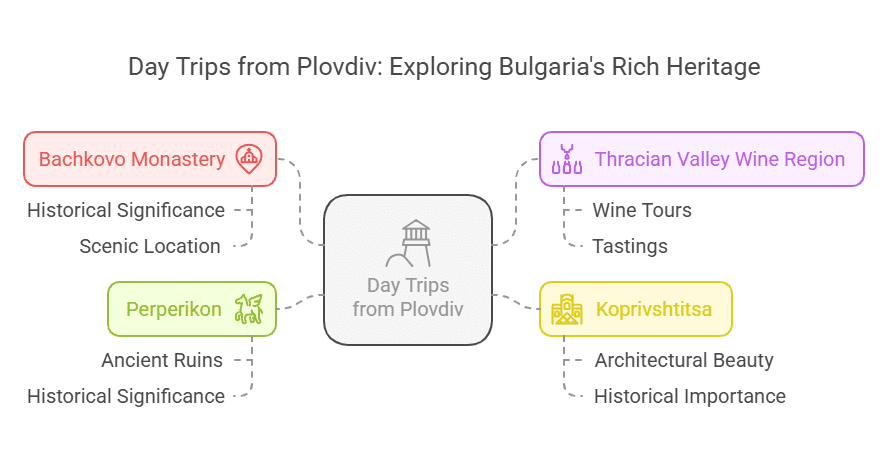
Its location in the picturesque Rhodope Mountains makes the journey almost as rewarding as the destination.
Wine enthusiasts should consider a day trip to the nearby Thracian Valley wine region, where numerous wineries offer tours and tastings of Bulgaria’s increasingly respected wines.
The town of Koprivshtitsa, though requiring a slightly longer journey, rewards visitors with incredibly well-preserved Bulgarian Revival architecture and a significant place in the country’s struggle for independence from Ottoman rule.
The ancient Thracian city of Perperikon, with ruins that date back millennia, offers another fascinating day trip from Plovdiv for history buffs.
These excursions complement the city experience and reveal more of the rich cultural tapestry that makes this part of Bulgaria so worth exploring.
When Is the Best Time to Visit Plovdiv?
The ideal time to experience the best places to visit in Plovdiv is during the late spring (May-June) or early autumn (September-October) when temperatures are pleasant, tourist crowds are thinner, and the city’s numerous gardens are at their most beautiful.

During these shoulder seasons, you can comfortably enjoy walking tours through the Old Town and Kapana district while appreciating the outdoor cafes and restaurants that line the city’s main pedestrian street.
Summer (July-August) brings hot temperatures and more tourists, but also comes alive with numerous festivals, outdoor concerts at the Roman Theatre, and the famous evening performances of the Singing Fountains in Tsar Simeon Garden.
Winter offers a different charm, with Christmas decorations adorning the streets and the possibility of seeing the surrounding hills dusted with snow.
Each season showcases different aspects of Plovdiv’s charm, but the moderate temperatures and cultural events of late spring and early autumn make these periods particularly appealing for exploring all the top attractions in Plovdiv without the summer heat or winter chill.
Where Are the Hidden Gems in Plovdiv That Most Tourists Miss?
While most visitors focus on the well-known attractions in Plovdiv like the Old Town and Roman Theatre, the city harbors several lesser-known treasures worth seeking out.
The Dzhumaya Mosque, dating from the 14th century during Ottoman rule, is one of the oldest European mosques still in use and features beautiful interior decorations.
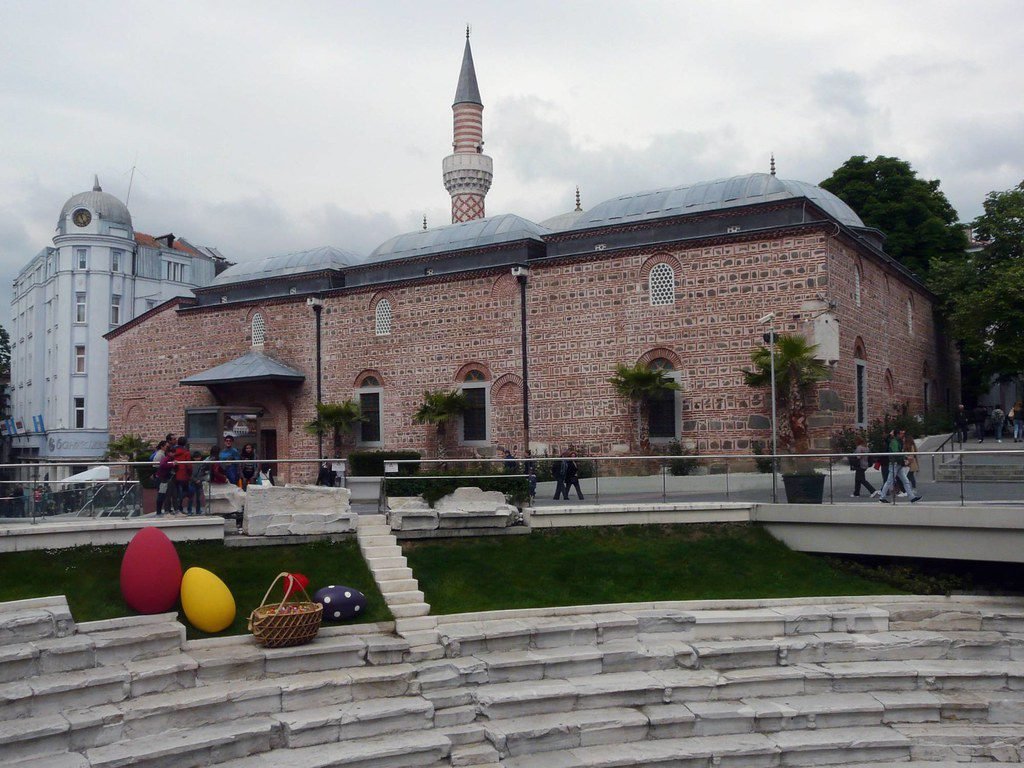
Nearby, beneath a glass dome, you can view portions of the ancient Roman stadium that once stretched 240 meters through what is now the city center.
Nebet Tepe, one of Plovdiv’s three hills, offers panoramic views of the city and contains the oldest traces of civilization in Plovdiv, with fortress walls dating back to Thracian times.
The Defense Tower is a hidden spot that provides insight into the city’s military history. For art lovers, the small but fascinating Museum of Modern Art showcases contemporary Bulgarian artists away from the tourist crowds.
These hidden gems in Plovdiv provide a deeper understanding of the city’s layered history and culture beyond the major attractions, rewarding curious travelers who venture off the standard tourist path.
What’s the Best Way to Get Around and Stay in Plovdiv?
Plovdiv is a wonderfully walkable city, especially in the central areas, Old Town, and Kapana district.

The main pedestrian street (Knyaz Alexander I) connects many of the city’s highlights, making walking the preferred method for exploring the best places to visit in Plovdiv.
For longer distances, the city has an efficient public bus system, and taxis are affordable and readily available.
Regarding accommodation, Plovdiv offers options for every budget and preference. For a truly atmospheric experience, stay in a guest house in the Old Town of Plovdiv, many of which are housed in restored Revival period buildings.
The Residence City Garden and Hotel Evmolpia offer comfortable accommodations in historic settings.
For those preferring modern amenities, the area around the main pedestrian street provides excellent mid-range hotels with convenient access to Plovdiv tourist attractions.
Budget travelers will find good value at Hostel Old Plovdiv or numerous other guest houses throughout the city. No matter where you choose to stay, Plovdiv’s compact nature ensures you’re never far from its major attractions.
How Much Time Should You Allocate for Exploring Plovdiv?
While some travelers visit Plovdiv as a day trip from Sofia, the city deserves at least 2-3 full days to properly experience its diverse attractions and unique atmosphere.
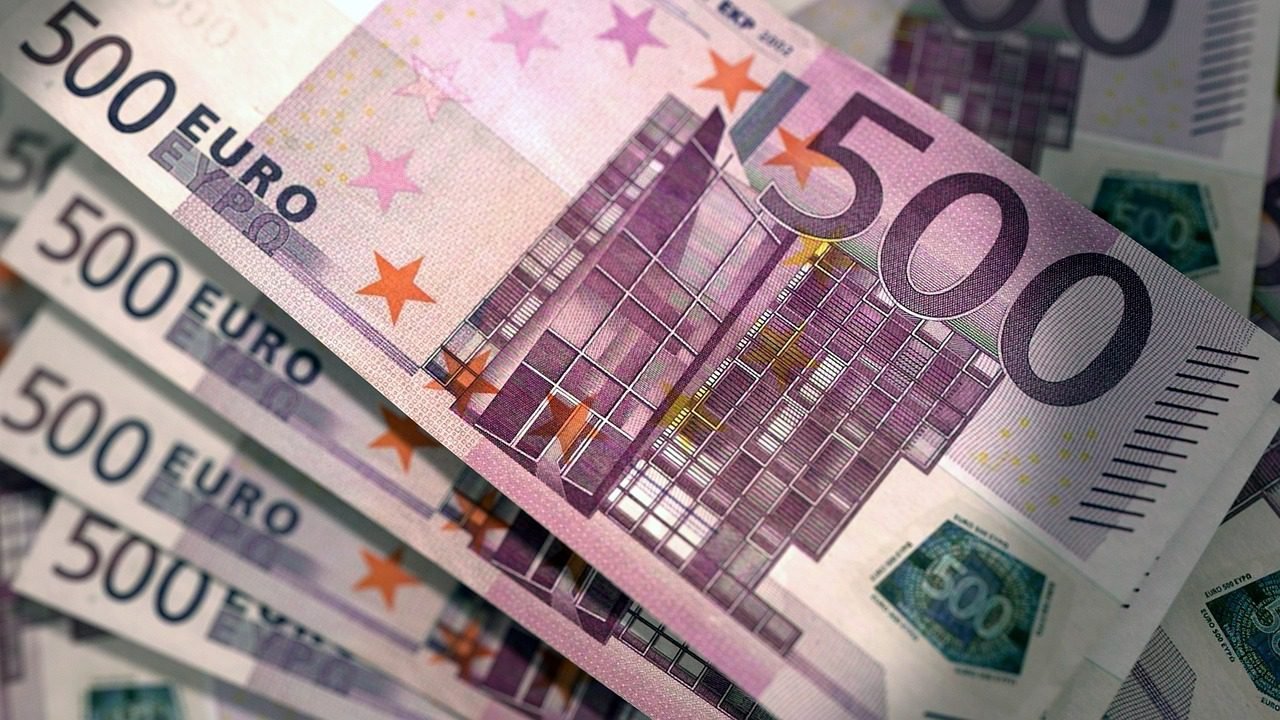
A comprehensive Plovdiv itinerary should include a full day dedicated to the Old Town and its museum-houses, allowing time to appreciate the architectural details and historical significance of this remarkable district.
Another day could focus on the Roman ruins and main museums, giving these impressive sites the attention they deserve.
Reserve at least half a day for wandering through the Kapana district, where the pleasure comes from unhurried exploration of its creative spaces and vibrant atmosphere.
If time allows, adding an extra day for a day trip to the surrounding region will round out your Bulgarian experience.
With its walkable size yet densely packed attractions, Plovdiv offers one of the best places to visit in Bulgaria for those seeking to maximize cultural experiences without excessive travel time between sites.
Frequently Asked Questions About Visiting Plovdiv
Is Plovdiv worth visiting compared to Sofia?
Absolutely! While Sofia is Bulgaria’s capital and has its own attractions, Plovdiv offers a more compact, walkable experience with an exceptional concentration of historical sites.
Many travelers actually prefer Plovdiv for its relaxed atmosphere, better-preserved Old Town, and vibrant cultural scene.
As the second largest city in Bulgaria with one of the best-preserved ancient theaters in the world, Plovdiv definitely deserves at least 2-3 days of exploration during any trip to Bulgaria.
Do people speak English in Plovdiv?
English is widely spoken in Plovdiv, especially among younger people and those working in the tourism industry.
You’ll find English menus in most restaurants in Plovdiv, particularly in the Old Town and Kapana district.
Major Plovdiv tourist attractions have information in English, and many museums offer English-language tours or audio guides. That said, learning a few basic Bulgarian phrases is always appreciated by locals.
How do I get from Sofia to Plovdiv?
The distance between Sofia and Plovdiv is about 150 km, and there are several convenient transportation options. The fastest is by car or taxi, taking approximately 1.5 hours via highway.
Buses run frequently (almost hourly) and take about 2 hours. Trains are another option, with the journey taking 2.5-3 hours depending on the service.
Many travelers choose to visit Plovdiv as a day trip from Sofia, though the best places to visit in Plovdiv really deserve more time.
Is Plovdiv expensive for tourists?
Plovdiv is quite affordable by European standards. A good meal at mid-range restaurants in Plovdiv typically costs €10-15 per person, while budget options can be found for €5-7.
Accommodation ranges from €15-20 for hostels to €40-70 for nice mid-range hotels. Museum entrance fees are typically under €5, and public transportation is very inexpensive.
Overall, you can enjoy the top attractions in Plovdiv and have a comfortable stay for significantly less than in Western European destinations.
What are the must-try Bulgarian dishes in Plovdiv?
When dining at the best restaurants in Plovdiv, be sure to try shopska salad (tomatoes, cucumbers, peppers, and white cheese), banitsa (cheese-filled pastry), kavarma (slow-cooked meat stew served in a clay pot), kyufte and kebapche (grilled meat patties and sausages), and tarator (cold cucumber soup).
Local specialties around Plovdiv include dishes with rice and herbs reflecting the region’s agricultural heritage.
Don’t miss the opportunity to pair your meal with wines from the nearby Thracian Valley, especially the local red varieties of Mavrud and Rubin.


